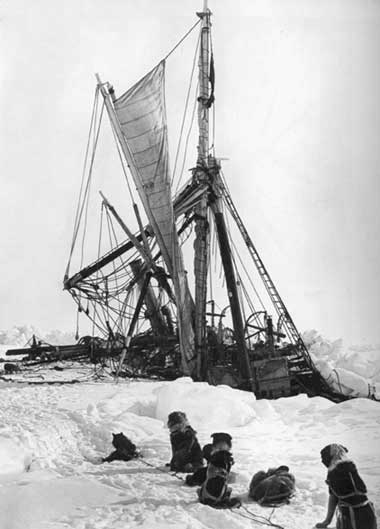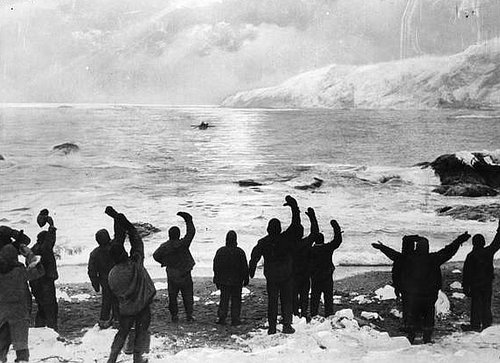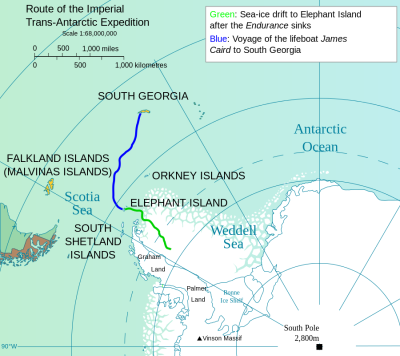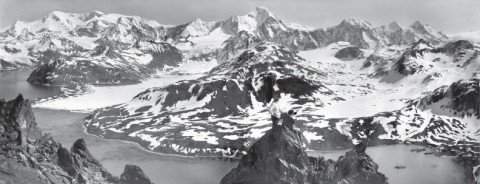
One hundred years ago this week, the explorer Ernest Shackleton and his crew aboard the schooner Endurance left the port of the Grytviken whaling station on South Georgia Island in the South Atlantic to the continent of Antartica. The goal was a never before achieved transcontinental traverse across one of the remotest places on earth. It would be their last touch with civilization for the next one and half years, and it would be an utter failure. The extent of the failure, and the spectacular story of survival, courage, leadership and outright moxie required to bring the participants back to civilization is the basis of one of the most uplifting stories of human achievement and one hundred years later, remains a riveting example of meeting your own flaws and mortality head on and overcoming to inspire us all.
One has to put into the perspective the age that men were living in, and that it was the age of men. Ernest Shackleton was a man of his age. He sought to test himself and others to expand the limits of what was known and did not terribly worry about the consequences or risks of such traits. He had participated in a previous Antarctic expeditions including one with the famous explorer Robert Scott who later lost his life in the return voyage from achieving the South Pole, in a mission that Shackleton had planned to be his own. Having had to except the reality that the glory of first to the pole rested in the hands of the Norwegian explorer Roald Amundsen, who beat Scott to the pole by three weeks, Shackleton wanted to establish a British success that would be of import, the transcontinental voyage that would require more spectacular planning and logistics, in keeping with his sense of being a man of the Empire. He did it in the old empire sense of understatement, not asking for public support but rather going to a few rich brokers with similar sense of empire to fund the expected costs of such a complex expedition, approaching 5 million in today’s dollars. For crew, he called on a few loyal men of extraordinary talents who had served with him previously, and for other parts of the crew, a simple understated call to adventure advertisement in the local paper.

The genius of Shackleton’s leadership did not present with the planning of the voyage. Limited by the primitive communication of the day, the difficult logistics relied on the almost perfect and thereby implausible timing of events and cooperative weather that very soon showed the flaws in Shackleton’s expeditionary capabilities. The Endurance sailed across the Weddell Sea to the Ronne Ice Shelf in sight of continental land but hampered by a progressively treacherous current pushed ice pack which eventually locked the ship in from the open sea on February 14th, 1915. Tremendous efforts by the crew to free the Endurance from the ice proved fruitless, and Shackleton realized the boat would have to wait out the ferocious Antarctic winter in the ice, hopefully to be freed by the next spring and summer’s melt off.
He had been locked in the ice before on the Scott expedition , but had been able to free himself, so he assumed with patience the same could occur for the Endurance. He was wrong, horribly wrong, and by the intense winter of June through August the pack progressively thickened and began to put massive pressures on the boat’s structure. By September, the boat was in dire straights, crushed against massive heaving flows of millions of tons of ice, and the inevitable occurred on October 27,1915 – the ship was abandoned and slowing sinking began.
And so really begins the story out of utter failure. The depths of imagination and courage needed to survive are beautifully told in Alfred Lansing’s book the Endurance , and can not be done justice in a few paragraphs in this blog. What Shackleton showed in the face of crisis is the basis for this blog, however, and the key moments are forever inspirational. What does one do in the face of complete collapse and frank threat to your leadership? Shackleton’s decision was to show even greater leadership. He announced to the crew that the purpose of the expedition was now fully to achieve the survival of the participants and he was confident through shared sacrifice this could be accomplished. A score of men alone with limited food and poor survival gear floating on an ice flow over a hundred miles from land and a thousand miles from civilization seemed an impossible task and the men felt it, but Shackleton never let them see that he felt it. He would lead them to safety. The road to safety was the open sea, and therefore the three rescue boats on the Endurance would have to be the means of escape. Men would have to physically drag them over ice flows and knee deep snow over uncountable miles until free water was seen. Day after day the harsh realities were documented by the mission photographer, Frank Hurley, who brought visual confirmation to the incredible facts of the escape effort. Through maps and reckoning, the distance to shelter was felt to be three hundred miles-the highest speed of cross ice transit was seven miles a day. It became eventually clear the men’s incredible effort would come for nought unless luck would intervene, and luck came in the form of fracturing of the ice pack on April 9th, and Shackleton’s decision to man the ice boats and attempt to make Elephant Island, the last outpost of Antarctica before the open sea, and certain death. Five days in the ocean led them to a landing on Elephant Island and land.
Land was a generous term as the island was essentially inhospitable and the weather still atrocious. Shackleton had gotten them this far, and announced that the majority of the crew could take refuge, and he, Shackleton, would take the 22 foot rescue boat across the open Weddell Sea to civilization and help.
That would be 800 miles across what was uniformly known as some of the worst sailing sea in the world in a 22 foot boat to hopefully reach South Georgia Island and civilization – the equivalent of being a cork in the ocean that actually found itself back into its original bottle. To Shackleton however, it was doable, and as he had gotten them into this mess, he would do whatever was necessary to get them out. On April 24, 1916, Shackleton launched the James Caird with his chief navigator, Frank Worsley who had only a chronometer and dead reckoning to guide him across the difficult ocean, and four sailors. The twenty or so crewmen of the Endurance who stayed behind on Elephant Island, waved him goodbye, and assumed that they were waving goodbye to their commander, and their own hopes for survival.

England by the spring of 1916 had been in brutal war for a year and a half, and having heard nothing from Shackleton and the Endurance crew, assumed them dead. The forlorn men on Elephant Island knew they were as good as dead as no one knew they were there but Shackleton, and he was attempting the impossible. For Shackleton, the impossible was only present through the release of death from responsibility, and as such, still, alive, he trudged across the Weddell Sea in his little boat through impossibly rough seas approaching thirty feet, gales that would have sunk a boat hundreds of feet larger, and nothing to prevent him from floating to death into the vast Atlantic Ocean other than the indefensible luck of successfully navigating to little South Georgia Island.
After 800 miles of vicious open sea, in a navigating achievement that no modern sailor with the most sophisticated gear would want to attempt, the James Caird reached South Georgia Island on May 10th, 1916.
The exhausted men of the James Caird found themselves on the opposite side of the island from the small whaling station and rescue. All that stood in the way were mountain peaks thousands of feet high covered with treacherous ice and glaciers.

The men had soggy woolen clothes and a few ropes. As if the travail across the sea was not challenge enough, the men tackled the climbs with desperation, finding themselves finally within site of the station but separated by a sheer three thousand foot drop. No residual strength was present so they took one last chance, improvised a rope sleigh and through themselves off. Minutes later, whaling station inhabitants looked up to see four other worldly bedraggled men impossibly appearing from the impenetrable mountain side.
One of the four was Ernest Shackleton.
Shackleton fulfilled his promise to his men, eventually achieving a successful rescue mission to Elephant Island, and his stranded men, on August 30th,1916. The shock and joy that the impossible rescue had been achieved was for the men alone. Upon returning to England, the men found a nation distracted and immersed in war, and the immensity of their survival achievement took years to absorb. This was a generation of service, not plaudits, however, and most went on to serve in World War I, some dying in battle, after cheating death in Antarctica.
Ernest Shackleton remained somewhat of a celebrity, and even somewhat of an explorer, dying of a heart attack in 1921, in all places, South Georgia Island intent upon leading yet another expedition to the icy continent. It took several generations to fully absorb what he accomplished in failure, progressively appreciated as the technology improved and recognized what he had accomplished. What he had done was be the best kind of leader, a leader that does everything he can to share in the sacrifice and find a way out of chaos, in a way that the men and women being led are willing to be led, no matter what the consequences. Shackleton took responsibility, showed his followers that you try until you die, and you use what you have to succeed at whatever odds and challenges, Through meeting a challenge no matter how harsh the consequence, the capacity to succeed revolves around the willingness to risk failure, and be content, with the idea you tried your very,very best.
“It is not the critic who counts; not the man who points out how the strong man stumbles, or where the doer of deeds could have done them better. The credit belongs to the man who is actually in the arena, whose face is marred by dust and sweat and blood; who strives valiantly; who errs, who comes short again and again, because there is no effort without error and shortcoming; but who does actually strive to do the deeds; who knows great enthusiasms, the great devotions; who spends himself in a worthy cause; who at the best knows in the end the triumph of high achievement, and who at the worst, if he fails, at least fails while daring greatly, so that his place shall never be with those cold and timid souls who neither know victory nor defeat.”
― Theodore Roosevelt